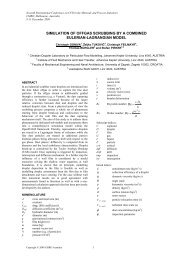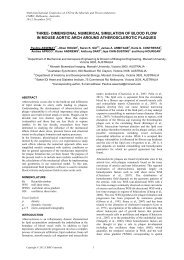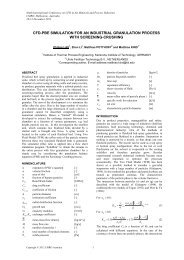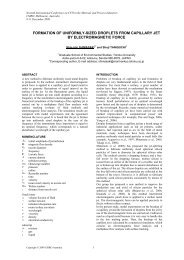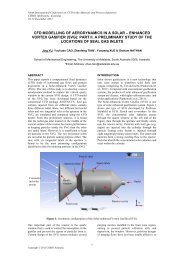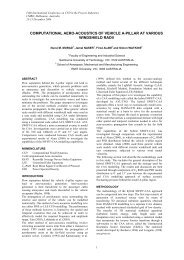preliminary sph modelling of oxide formation during the - CFD
preliminary sph modelling of oxide formation during the - CFD
preliminary sph modelling of oxide formation during the - CFD
You also want an ePaper? Increase the reach of your titles
YUMPU automatically turns print PDFs into web optimized ePapers that Google loves.
Fifth International Conference on <strong>CFD</strong> in <strong>the</strong> Process Industries<br />
CSIRO, Melbourne, Australia<br />
13-15 December 2006<br />
PRELIMINARY SPH MODELLING OF OXIDE FORMATION DURING THE MOULD<br />
FILLING PHASE IN DC CASTING OF EXTRUSION BILLETS<br />
ABSTRACT<br />
Mahesh PRAKASH #1 , Joseph HA #1 , Paul W. CLEARY #1 and John GRANDFIELD #2<br />
# CAST Cooperative Research Centre,<br />
1 CSIRO Ma<strong>the</strong>matical and In<strong>formation</strong> Sciences, Clayton, VIC 3169<br />
2 CSIRO Manufacturing and Materials Technology, Preston, VIC 3072<br />
Direct chill (DC) casting is widely used to produce<br />
aluminium ingots and billets. One <strong>of</strong> <strong>the</strong> issues with such<br />
castings is <strong>the</strong> <strong>oxide</strong> generated especially <strong>during</strong> <strong>the</strong><br />
filling <strong>of</strong> <strong>the</strong> casting table in <strong>the</strong> start-up phase. This<br />
<strong>oxide</strong> can affect <strong>the</strong> performance <strong>of</strong> <strong>the</strong> product <strong>during</strong><br />
subsequent extrusion. While <strong>the</strong> very first material is cut<br />
<strong>of</strong>f and discarded <strong>the</strong> distribution <strong>of</strong> <strong>oxide</strong>s along <strong>the</strong> cast<br />
length is not known. It is <strong>the</strong>refore highly desirable to<br />
have an ability to predict <strong>the</strong> amount and distribution <strong>of</strong><br />
<strong>the</strong> <strong>oxide</strong> generated <strong>during</strong> <strong>the</strong> process start-up. In this<br />
paper, we use <strong>the</strong> mesh-free Smoo<strong>the</strong>d Particle<br />
Hydrodynamics (SPH) method to model <strong>the</strong> mould filling<br />
phase <strong>of</strong> DC casting. The free surface nature <strong>of</strong> <strong>the</strong> flow<br />
<strong>during</strong> this phase is especially amenable to <strong>the</strong> mesh-free<br />
SPH <strong>modelling</strong> technique. Additionally this method is<br />
very suitable for predicting surface driven and history<br />
dependent properties such as <strong>oxide</strong>s. The paper presents<br />
<strong>preliminary</strong> predictions <strong>of</strong> cumulative interior and<br />
exterior <strong>oxide</strong> levels with time in a typical DC casting<br />
operation. The amount <strong>of</strong> interior <strong>oxide</strong> will indicate <strong>the</strong><br />
effect <strong>of</strong> <strong>oxide</strong> on <strong>the</strong> final metal microstructure. The<br />
amount <strong>of</strong> exterior <strong>oxide</strong> determines <strong>the</strong> surface quality<br />
<strong>of</strong> <strong>the</strong> billet.<br />
INTRODUCTION<br />
In direct chill (DC) casting, molten aluminium is poured<br />
from <strong>the</strong> furnace through a troughing system into a<br />
refractory mould table placed on water box containing<br />
moulds <strong>of</strong> <strong>the</strong> desired billet diameter as shown in Figure<br />
1.After filling <strong>the</strong> starting heads in <strong>the</strong> mould, <strong>the</strong> mould<br />
descends and <strong>the</strong> emerging billets are cooled by <strong>the</strong> direct<br />
chill water spray.<br />
During aluminium melt transfer <strong>oxide</strong>s can form which<br />
are detrimental to <strong>the</strong> product quality and cause defects<br />
<strong>during</strong> extrusion. Filters are used in <strong>the</strong> transfer from <strong>the</strong><br />
furnace to <strong>the</strong> DC casting process to remove <strong>oxide</strong>s and<br />
o<strong>the</strong>r particles. However, filling <strong>of</strong> <strong>the</strong> mould table takes<br />
place after <strong>the</strong> filter and <strong>during</strong> this filling stage <strong>oxide</strong>s<br />
can be generated. At present <strong>the</strong>re is no easy way <strong>of</strong><br />
experimentally evaluating <strong>the</strong> amount <strong>of</strong> <strong>oxide</strong> produced<br />
<strong>during</strong> such operations as a function <strong>of</strong> table design or<br />
filling practice. Thermal related defects can also occur at<br />
<strong>the</strong> start <strong>of</strong> casting due to too short or too long a mould<br />
filling time. Thus, one desires a mould table design<br />
which minimizes filling time variation from mould to<br />
mould, fills fast enough and does not create turbulence,<br />
splashing and <strong>oxide</strong>s. The mould table can have more<br />
than 100 billets depending on <strong>the</strong> diameter.<br />
1<br />
In <strong>the</strong> past, <strong>modelling</strong> <strong>of</strong> <strong>the</strong> flow and temperatures<br />
<strong>during</strong> DC casting table filling have been carried out<br />
using mesh based methods such as <strong>the</strong> general purpose<br />
FEM code FIDAP (Schneider and Grun, 1995, Grun and<br />
Schneider, 1997 and Grun and Schneider, 1998).<br />
Smoo<strong>the</strong>d Particle Hydrodynamics (SPH), due to its<br />
Lagrangian nature, is well suited to simulating <strong>the</strong><br />
complex free surface flow, such as found in <strong>the</strong> DC<br />
casting start-up phase. It also has strong advantages in<br />
simplifying predictions <strong>of</strong> <strong>oxide</strong> generation and transport,<br />
allowing estimates to be made <strong>of</strong> interior and exterior<br />
<strong>oxide</strong> content in a given metal casting system. These<br />
advantages have led to <strong>the</strong> use <strong>of</strong> SPH in several casting<br />
processes including prediction <strong>of</strong> <strong>oxide</strong> content and<br />
optimization <strong>of</strong> wheel design in aluminium re-melt ingot<br />
casting reported in Cleary et al. (2004) and Prakash et al.<br />
(2006), high pressure die-casting in Cleary et al. (2000)<br />
and Cleary and Ha (2003) and gravity die casting Ha et<br />
al. (1999).<br />
Trough<br />
Mould table<br />
(b)<br />
Figure 1: Schematic showing (a) a vertical and (b) a side<br />
view <strong>of</strong> <strong>the</strong> DC Casting configuration with a trough and<br />
mould table containing six moulds.<br />
(a)
SPH MODELLING<br />
SPH is a numerical method for <strong>modelling</strong> coupled fluid<br />
flows, solid structures and heat transfer with some unique<br />
capabilities. SPH is particle based ra<strong>the</strong>r than using<br />
conventional fixed grids or meshes to track <strong>the</strong> fluid and<br />
calculate <strong>the</strong> fluid velocities. The fluid is represented as<br />
“blobs” that move around in response to <strong>the</strong> fluid or solid<br />
stresses produced by <strong>the</strong> interaction with o<strong>the</strong>r particles.<br />
SPH is particularly well suited to momentum dominated<br />
flows, flows involving complex free surface behaviour<br />
and flows with complex physics such as solidification or<br />
flow through industrial porous media. It is also useful for<br />
flows around moving objects, since <strong>the</strong>re are no mesh<br />
structures to be affected.<br />
A brief summary <strong>of</strong> <strong>the</strong> SPH method is presented here.<br />
For more comprehensive details one can refer to Gingold<br />
and Monaghan (1977), Monaghan (1992) and Cleary and<br />
Monaghan (1999). The interpolated value <strong>of</strong> a function A<br />
at any position r using SPH smoothing can be written as:<br />
A<br />
b<br />
( r)<br />
∑ mb<br />
W ( r − rb<br />
h)<br />
A = ,<br />
b ρb<br />
where mb and rb are <strong>the</strong> mass and density <strong>of</strong> particle b<br />
and <strong>the</strong> sum is over all particles b within a radius 2h <strong>of</strong> r.<br />
Here W(r,h) is a C 2 spline based interpolation or<br />
smoothing kernel with radius 2h, that approximates <strong>the</strong><br />
shape <strong>of</strong> a Gaussian function but has compact support.<br />
The gradient <strong>of</strong> <strong>the</strong> function A is given by differentiating<br />
<strong>the</strong> interpolation equation (1) to give:<br />
Ab<br />
∇A<br />
( r)<br />
= ∑mb<br />
∇W<br />
( r − rb<br />
, h)<br />
(2)<br />
b ρb<br />
Using <strong>the</strong>se interpolation formulae and suitable finite<br />
difference approximations for second order derivatives,<br />
one is able to convert parabolic partial differential<br />
equations into ordinary differential equations for <strong>the</strong><br />
motion <strong>of</strong> <strong>the</strong> particles and <strong>the</strong> rates <strong>of</strong> change <strong>of</strong> <strong>the</strong>ir<br />
properties.<br />
Continuity equation:<br />
From Monaghan (1992), <strong>the</strong> SPH continuity equation is:<br />
(1)<br />
dρ<br />
a<br />
∑mb<br />
( va<br />
− vb<br />
) • ∇W<br />
(3)<br />
ab<br />
dt<br />
= b<br />
where ρa is <strong>the</strong> density <strong>of</strong> particle a with velocity va and<br />
mb is <strong>the</strong> mass <strong>of</strong> particle b. We denote <strong>the</strong> position<br />
vector from particle b to particle a by rab = ra<br />
− rb<br />
and<br />
= W r , h be <strong>the</strong> interpolation kernel with<br />
let ( )<br />
Wab ab<br />
smoothing length h evaluated for <strong>the</strong> distance r ab . This<br />
form <strong>of</strong> <strong>the</strong> continuity equation is Galilean invariant<br />
(since <strong>the</strong> positions and velocities appear only as<br />
differences), has good numerical conservation properties<br />
and is not affected by free surfaces or density<br />
discontinuities.<br />
Momentum equation:<br />
The SPH momentum equation used here is:<br />
⎡⎛<br />
P P ⎞<br />
⎜ + ⎟<br />
b a<br />
⎢<br />
d<br />
⎜ 2 2<br />
⎥<br />
v<br />
⎟<br />
a<br />
b a<br />
m ⎢⎝<br />
ρ ρ<br />
(4)<br />
= g −<br />
⎠<br />
⎥<br />
∑ b<br />
∇ aWab<br />
dt<br />
⎢<br />
⎥<br />
b ξ 4μ<br />
a μ b v abrab<br />
⎢−<br />
⎥<br />
2 2<br />
⎢⎣<br />
ρ a ρ b ( μ a + μb<br />
) rab<br />
+ η ⎥⎦<br />
where Pa and μa are pressure and viscosity <strong>of</strong> particle a<br />
and vab = va<br />
− vb<br />
. Here ξ is a factor associated with<br />
⎤<br />
2<br />
<strong>the</strong> viscous term (Cleary, 1996), η is a small parameter<br />
used to smooth out <strong>the</strong> singularity at rab = 0 and g is <strong>the</strong><br />
gravity vector. The first two terms involving <strong>the</strong> pressure<br />
correspond to <strong>the</strong> pressure gradient term <strong>of</strong> <strong>the</strong> Navier-<br />
Stokes equation. The next term involving viscosities is<br />
<strong>the</strong> Newtonian viscous stress term.<br />
Equation <strong>of</strong> state:<br />
Since <strong>the</strong> SPH method used here is quasi-compressible<br />
one needs to use an equation <strong>of</strong> state, giving <strong>the</strong><br />
relationship between particle density and fluid pressure.<br />
This relationship is given by <strong>the</strong> expression:<br />
γ ⎡⎛<br />
ρ ⎞ ⎤<br />
P = P ⎢<br />
⎜<br />
⎟<br />
0 −1⎥<br />
⎢⎣<br />
⎝ ρ0<br />
⎠ ⎥⎦<br />
where P0 is <strong>the</strong> magnitude <strong>of</strong> <strong>the</strong> pressure and ρ0 is <strong>the</strong><br />
reference density. For water and liquid metals we use γ<br />
=7. This pressure is <strong>the</strong>n used in <strong>the</strong> SPH momentum<br />
equation (4) to give <strong>the</strong> particle motion. The pressure<br />
scale factor P0 is given by:<br />
γ P0<br />
2 2<br />
= 100V = c<br />
(6)<br />
s<br />
ρ0<br />
where V is <strong>the</strong> characteristic or maximum fluid velocity.<br />
This ensures that <strong>the</strong> density variation is less than 1% and<br />
<strong>the</strong> flow can be regarded as incompressible.<br />
Oxide <strong>modelling</strong>:<br />
Aluminium <strong>oxide</strong> grows on <strong>the</strong> surface <strong>of</strong> molten<br />
aluminium due to exposure to air. This <strong>oxide</strong> layer can be<br />
broken by flow <strong>of</strong> <strong>the</strong> melt creating new surface. The<br />
surface may be folded over on itself entraining <strong>the</strong> <strong>oxide</strong><br />
films. Any splashing will result in droplets <strong>of</strong> melt<br />
surrounded by <strong>oxide</strong> film that become dross on <strong>the</strong><br />
surface melt. To quantify this <strong>oxide</strong> <strong>formation</strong>, a linear<br />
<strong>oxide</strong> (Ox) growth model suggested by Baker et al.<br />
(1995) is used:<br />
dO<br />
x<br />
dt<br />
= k l<br />
(7)<br />
where kl is <strong>the</strong> rate constant and t time. These authors<br />
estimated <strong>the</strong> rate constant to be<br />
−3<br />
2<br />
= 10.<br />
9 × 10 kg/m s .<br />
Note that <strong>the</strong> <strong>oxide</strong> is transported with <strong>the</strong> fluid and no<br />
account <strong>of</strong> any apparent density difference causing <strong>the</strong><br />
<strong>oxide</strong> to sink or rise is allowed for.<br />
DC CASTING MODEL SETUP<br />
A unit <strong>of</strong> 6 moulds was modelled for simplicity. The<br />
dimension <strong>of</strong> <strong>the</strong> DC casting mould table given in Figure<br />
1 is 0.83 m long and 0.575 m wide with a gate width <strong>of</strong><br />
0.114 m. There are six circular moulds in <strong>the</strong> table each<br />
with diameter 0.135 m. The design used is a conceptual<br />
one typical <strong>of</strong> industry practice. A starting head, mounted<br />
to a hydraulic ram, forms a false bottom to <strong>the</strong> mould.<br />
When <strong>the</strong> mould is filled and <strong>the</strong> metal begins to solidify,<br />
<strong>the</strong> starting head is lowered at a controlled rate. As <strong>the</strong><br />
starting head lowers, water jets built into <strong>the</strong> mould spray<br />
water onto <strong>the</strong> billet to cool <strong>the</strong> surface and fur<strong>the</strong>r<br />
solidify <strong>the</strong> metal. Multiple moulds in <strong>the</strong> table contribute<br />
to high production rates in <strong>the</strong> cast house.<br />
The metal height in <strong>the</strong> launder system is kept constant at<br />
70 mm with respect to <strong>the</strong> base <strong>of</strong> <strong>the</strong> mould table. This<br />
pressure head thus controls <strong>the</strong> flow to <strong>the</strong> mould table.<br />
In practice <strong>the</strong> metal head depends on <strong>the</strong> flow rate from<br />
k l<br />
(5)
<strong>the</strong> furnace. To represent this pressure head in <strong>the</strong> SPH<br />
simulation, a reservoir <strong>of</strong> fluid <strong>of</strong> fixed height is placed in<br />
<strong>the</strong> launder in front <strong>of</strong> <strong>the</strong> gate as shown in Figure 2. A<br />
pressure inflow boundary condition <strong>of</strong> 1614 Pa is applied<br />
at <strong>the</strong> inflow to <strong>the</strong> reservoir to maintain a steady head <strong>of</strong><br />
70 mm while at <strong>the</strong> same time achieving a mould table<br />
fill time <strong>of</strong> around 30 seconds. The descent <strong>of</strong> <strong>the</strong> starting<br />
head is not simulated. The model is iso<strong>the</strong>rmal.<br />
Inflow<br />
Reservoir To Mould<br />
Table<br />
Figure 2: Cross section <strong>of</strong> <strong>the</strong> constant head inflow<br />
reservoir used to control <strong>the</strong> inflow to <strong>the</strong> mould table.<br />
A resolution <strong>of</strong> 5 mm was used for <strong>the</strong> particles<br />
representing <strong>the</strong> molten metal, <strong>the</strong> moulds and mould<br />
table. The number <strong>of</strong> particles used for <strong>the</strong> geometry is<br />
123,321. The number <strong>of</strong> fluid particles increases with<br />
time as more and more particles are generated by <strong>the</strong><br />
inflow. The final number <strong>of</strong> fluid particles when <strong>the</strong><br />
mould is full is around 120,000.<br />
Figure 3 shows <strong>the</strong> variation <strong>of</strong> inflow pressure and<br />
velocity as it adapts to fluid flow causing a ramp up in<br />
pressure to maintain <strong>the</strong> specified pressure head.<br />
FLOW PATTERN IN DC CASTING TABLE<br />
Figure 4 shows <strong>the</strong> filling <strong>of</strong> <strong>the</strong> mould table. The<br />
molten metal is coloured by speed in frames on <strong>the</strong> left<br />
and by <strong>oxide</strong> fraction in <strong>the</strong> frames on <strong>the</strong> right. The<br />
metal speed is coloured with red being <strong>the</strong> maximum <strong>of</strong><br />
0.21 m/s and blue being stationary. The <strong>oxide</strong> fraction is<br />
coloured with blue representing no <strong>oxide</strong> content and red<br />
representing a maximum <strong>of</strong> 6.8 μg/kg. At 3.0 s, <strong>the</strong> metal<br />
starts jetting into <strong>the</strong> table and has a very fragmented<br />
structure. There is some metal flowing into <strong>the</strong> first two<br />
moulds but most <strong>of</strong> it flows forward fur<strong>the</strong>r into <strong>the</strong> table<br />
at high speed.<br />
At 5.0 s, <strong>the</strong> molten metal is still very fragmented and <strong>the</strong><br />
leading material has now hit <strong>the</strong> end <strong>of</strong> <strong>the</strong> DC table.<br />
Once <strong>the</strong> metal hits <strong>the</strong> end <strong>of</strong> <strong>the</strong> table it slows and starts<br />
to backfill. The two moulds at <strong>the</strong> end <strong>of</strong> <strong>the</strong> table<br />
<strong>the</strong>refore start filling faster than <strong>the</strong> o<strong>the</strong>r four moulds.<br />
At 7.0 s, <strong>the</strong> back filling nature <strong>of</strong> <strong>the</strong> flow is evident<br />
with <strong>the</strong> two moulds at <strong>the</strong> end now almost 30 to 40%<br />
full. The base <strong>of</strong> <strong>the</strong>se moulds is almost fully covered by<br />
liquid metal. The four o<strong>the</strong>r moulds are less than 10%<br />
full at this stage. Modest but meaningful <strong>oxide</strong> levels are<br />
now observed close to <strong>the</strong> centre <strong>of</strong> <strong>the</strong> moulds as shown<br />
by <strong>the</strong> pale blue colour <strong>of</strong> <strong>the</strong> metal in <strong>the</strong> right frame.<br />
3<br />
a)<br />
Inflow Pressure (Pa)<br />
Inflow Velocity (m/s)<br />
2000<br />
1800<br />
1600<br />
1400<br />
1200<br />
1000<br />
800<br />
600<br />
400<br />
200<br />
0 5 10 15 20 25 30<br />
0.3<br />
0.28<br />
0.26<br />
0.24<br />
0.22<br />
0.2<br />
0.18<br />
0.16<br />
0.14<br />
0.12<br />
Time (s)<br />
0.1<br />
0 5 10 15 20 25 30<br />
b)<br />
Time (s)<br />
Figure 3: Variation <strong>of</strong> inflow pressure (bottom) and<br />
velocity (top) and with time.<br />
At 9.0 s, <strong>the</strong> last two moulds are almost 80% full with<br />
metal now starting to backfill <strong>the</strong> two moulds in <strong>the</strong><br />
middle <strong>of</strong> <strong>the</strong> table. There is a strong central jet <strong>of</strong> clean<br />
new metal coming into <strong>the</strong> table seen from <strong>the</strong> red<br />
coloured liquid in <strong>the</strong> centre at this stage. The liquid<br />
metal has slowed down considerably on <strong>the</strong> sides in <strong>the</strong><br />
moulds as well as at <strong>the</strong> end leading to <strong>the</strong> back filling.<br />
At 11.0 s, <strong>the</strong> backfilling <strong>of</strong> <strong>the</strong> middle two moulds is still<br />
in progress but <strong>the</strong> last two moulds at <strong>the</strong> end <strong>of</strong> <strong>the</strong> table<br />
are now almost completely full. The length <strong>of</strong> <strong>the</strong> central<br />
strong jet has started to diminish with this now occupying<br />
only one third <strong>of</strong> <strong>the</strong> table length.<br />
By 13.0 s <strong>the</strong> entire surface <strong>of</strong> <strong>the</strong> table is covered with<br />
metal. By this stage <strong>the</strong> back filling <strong>of</strong> <strong>the</strong> moulds has<br />
almost ceased and <strong>the</strong> strength <strong>of</strong> <strong>the</strong> central jet has also<br />
reduced considerably.<br />
Between 13.0 and 25.0 s <strong>the</strong>re is no significant change in<br />
<strong>the</strong> metal flow pattern. During this stage <strong>the</strong> entire<br />
surface <strong>of</strong> <strong>the</strong> table is covered with metal and <strong>the</strong> filling<br />
consists <strong>of</strong> a steadily rising depth <strong>of</strong> metal until it reaches<br />
<strong>the</strong> head level <strong>of</strong> 70 mm. The largest increase in metal fill<br />
level at this stage is for <strong>the</strong> two moulds at <strong>the</strong> front. The<br />
velocity and <strong>oxide</strong> distributions on <strong>the</strong> surface <strong>of</strong> <strong>the</strong><br />
metal do not vary significantly <strong>during</strong> this stage.
Figure 4: Filling patterns <strong>of</strong> DC mould table at different times. The fluid is coloured by speed (left column) and by <strong>oxide</strong><br />
mass (right column).<br />
4
Figure 4: Filling patterns <strong>of</strong> DC mould table at different times. The fluid is coloured by speed (left column) and by <strong>oxide</strong><br />
mass (right column).<br />
5
By 25.0 s, <strong>the</strong> entire table is filled with <strong>the</strong> metal depth<br />
reaching <strong>the</strong> required level <strong>of</strong> 70 mm thus completing <strong>the</strong><br />
start-up phase <strong>of</strong> <strong>the</strong> DC cast process. The central jet <strong>of</strong><br />
metal has now become weak as indicated by <strong>the</strong> pale blue<br />
colour on <strong>the</strong> left frames. Higher velocity regions are<br />
actually seen in <strong>the</strong> mould as <strong>the</strong> metal swirls around as<br />
indicated by <strong>the</strong> yellow to red colour in <strong>the</strong> six moulds.<br />
There is a steady increase <strong>of</strong> <strong>oxide</strong> level in <strong>the</strong> metal<br />
mass <strong>during</strong> this stage as seen by <strong>the</strong> change in colour <strong>of</strong><br />
<strong>the</strong> metal surface from pale blue to yellow.<br />
In general, <strong>the</strong> amount <strong>of</strong> <strong>oxide</strong> in <strong>the</strong> metal shows a<br />
gradual increase from <strong>the</strong> gate to <strong>the</strong> end <strong>of</strong> <strong>the</strong> table and<br />
a decrease from <strong>the</strong> central region to <strong>the</strong> sides <strong>of</strong> <strong>the</strong><br />
table. Due to <strong>the</strong> constant head condition <strong>the</strong> metal flow<br />
rate in <strong>the</strong> central region gradually diminishes as <strong>the</strong><br />
metal in <strong>the</strong> table rises up to <strong>the</strong> requisite level <strong>of</strong> 70 mm.<br />
Due to <strong>the</strong> low metal flow rate in <strong>the</strong> central region <strong>the</strong><br />
amount <strong>of</strong> <strong>oxide</strong> in this region is higher as <strong>the</strong> relatively<br />
slow moving metal is exposed to air for a longer time.<br />
Since <strong>the</strong> metal in <strong>the</strong> six moulds is moving around in a<br />
swirling pattern <strong>the</strong> <strong>oxide</strong> produced on <strong>the</strong> surface<br />
becomes entrained into <strong>the</strong> moulds leading to lower <strong>oxide</strong><br />
on <strong>the</strong> exterior moulds as seen from <strong>the</strong> pale blue colour<br />
<strong>of</strong> metal in <strong>the</strong> moulds in <strong>the</strong> right frame at 25.0 s.<br />
As fresh metal flows into <strong>the</strong> table from <strong>the</strong> gate, its<br />
exposure to <strong>the</strong> air as it flows down <strong>the</strong> table causes<br />
<strong>oxide</strong> to form. The metal in <strong>the</strong> region above <strong>the</strong> mould<br />
is constantly replenished by metal flowing from <strong>the</strong><br />
central region. In <strong>the</strong>se regions, <strong>the</strong> flow has a circular<br />
pattern with significant mixing. These results suggest that<br />
<strong>the</strong> surface layer <strong>of</strong> <strong>the</strong> metal in <strong>the</strong> central region <strong>of</strong> <strong>the</strong><br />
table is <strong>the</strong> primary location for <strong>oxide</strong> <strong>formation</strong>.<br />
OXIDE GENERATED DURING DC CAST FILLING<br />
Figure 5 shows <strong>the</strong> time variation <strong>of</strong> <strong>the</strong> total, interior and<br />
exterior <strong>oxide</strong> in <strong>the</strong> metal as a percentage <strong>of</strong> <strong>the</strong> metal<br />
mass in <strong>the</strong> table. The amount <strong>of</strong> <strong>oxide</strong> formed represents<br />
only a small fraction <strong>of</strong> <strong>the</strong> total metal. However this can<br />
be a significant absolute amount when <strong>the</strong> total<br />
aluminium DC cast production is taken into account.<br />
The percentage <strong>of</strong> total <strong>oxide</strong> in <strong>the</strong> metal increases<br />
almost linearly with time. By around 20 s <strong>the</strong> total<br />
percentage <strong>of</strong> <strong>oxide</strong> reaches a peak value <strong>of</strong> around<br />
0.31% and <strong>the</strong>n starts to gently decline.<br />
The percentage <strong>of</strong> external <strong>oxide</strong> increases rapidly at <strong>the</strong><br />
start with a level only slightly lower than for <strong>the</strong> total<br />
<strong>oxide</strong>. This indicates that most <strong>of</strong> <strong>the</strong> early <strong>oxide</strong> is on<br />
<strong>the</strong> surface where it is created. The external <strong>oxide</strong><br />
percentage reaches a maximum <strong>of</strong> about 0.15% at around<br />
12 s and <strong>the</strong>n slowly decreases as a proportion <strong>of</strong> total<br />
metal. This is expected since <strong>the</strong> total surface <strong>of</strong> <strong>the</strong><br />
mould table is constant, and thus <strong>the</strong> maximum surface<br />
area <strong>of</strong> <strong>the</strong> metal that can be exposed to air, is fixed. At<br />
<strong>the</strong> same time <strong>the</strong> total amount <strong>of</strong> metal in mould table<br />
increases steadily with time.<br />
The interior <strong>oxide</strong> curve has a slow rate <strong>of</strong> increase at<br />
first but <strong>the</strong>n increases more rapidly between 12 and 20 s.<br />
The total interior <strong>oxide</strong> content reaches a steady<br />
percentage <strong>of</strong> around 0.25% at 25 s. The steady level <strong>of</strong><br />
6<br />
interior <strong>oxide</strong> is maintained even with <strong>the</strong> addition <strong>of</strong><br />
more metal into <strong>the</strong> table suggesting that <strong>the</strong> actual level<br />
<strong>of</strong> interior <strong>oxide</strong> is increasing with time. This is because<br />
<strong>the</strong> strong levels <strong>of</strong> mixing in <strong>the</strong> moulds observed<br />
towards <strong>the</strong> end <strong>of</strong> <strong>the</strong> filling process, promotes <strong>the</strong><br />
entrainment <strong>of</strong> <strong>oxide</strong> into <strong>the</strong> metal interior. The interior<br />
<strong>oxide</strong> can result in possible defects in <strong>the</strong> billet. The<br />
exterior <strong>oxide</strong> on <strong>the</strong> o<strong>the</strong>r hand has a significant effect<br />
on <strong>the</strong> surface finish <strong>of</strong> <strong>the</strong> billet.<br />
Oxide (% <strong>of</strong> total metal mass)<br />
0.35<br />
0.3<br />
0.25<br />
0.2<br />
0.15<br />
0.1<br />
0.05<br />
Internal Oxide<br />
External Oxide<br />
Total Metal Oxide<br />
0<br />
0 5 10 15 20 25 30<br />
Time (s)<br />
Figure 5: Temporal variation <strong>of</strong> <strong>oxide</strong> as percentage <strong>of</strong><br />
total metal.<br />
CONCLUSIONS<br />
SPH simulation <strong>of</strong> DC casting gives a detailed prediction<br />
<strong>of</strong> <strong>the</strong> flow pattern <strong>of</strong> molten metal from <strong>the</strong> launder to<br />
<strong>the</strong> mould table, <strong>the</strong> rate <strong>of</strong> <strong>oxide</strong> <strong>formation</strong> on <strong>the</strong><br />
exposed metal surface and its subsequent entrainment<br />
into <strong>the</strong> metal.<br />
The Lagrangian nature <strong>of</strong> SPH makes it simple to track<br />
<strong>the</strong> movement <strong>of</strong> <strong>oxide</strong> from its <strong>formation</strong> on <strong>the</strong> exposed<br />
surface <strong>of</strong> <strong>the</strong> molten metal to its mixing into <strong>the</strong> fluid as<br />
<strong>the</strong> metal flows from <strong>the</strong> refractory to <strong>the</strong> mould table<br />
through <strong>the</strong> launder system.<br />
The simulation demonstrates:<br />
• The metal fill pattern in <strong>the</strong> mould table is strongly<br />
dependent on <strong>the</strong> metal flow speed. Faster metal<br />
speeds leads to more back filling whereas slower<br />
speeds can lead to a more front filling pattern.<br />
• Exterior and interior <strong>oxide</strong> in <strong>the</strong> metal can be<br />
predicted <strong>during</strong> <strong>the</strong> start-up phase using SPH.<br />
Exterior <strong>oxide</strong> is responsible for <strong>the</strong> surface finish <strong>of</strong><br />
<strong>the</strong> billet whereas interior <strong>oxide</strong> can affect <strong>the</strong> metal<br />
microstructure. Both properties significantly affect<br />
<strong>the</strong> usability <strong>of</strong> <strong>the</strong> final product.<br />
• SPH simulations can be used to evaluate <strong>oxide</strong> levels<br />
and fill patterns for different metal flow rates and<br />
mould arrangements in a DC table leading to an<br />
optimised DC casting system.<br />
In <strong>the</strong> next stage we will be comparing <strong>the</strong> SPH<br />
simulation results with water analogue <strong>modelling</strong> results<br />
as well as actual DC casting experimental results using<br />
molten metal.
ACKNOWLEDGMENTS<br />
This project was conducted by <strong>the</strong> CASTcrc. The support<br />
<strong>of</strong> Comalco and ODT Engineering are gratefully<br />
acknowledged. CSIRO, Comalco and ODT Engineering<br />
are core participants in <strong>the</strong> CASTcrc, which was<br />
established under and is supported in part by <strong>the</strong><br />
Australian Government's Cooperative Research Centres<br />
scheme.<br />
REFERENCES<br />
BAKER, P.W., NGUYEN, K., KIRKALDIE, R.,<br />
(1995), in Aluminium Cast House Technology 4th<br />
Australasian Asian Pacific Conference, TMS, p. 109.<br />
CLEARY, P., (1996), “New implementation <strong>of</strong><br />
viscosity: tests with Couette flows.” SPH Technical Note<br />
8, CSIRO DMS, Technical Report DMS – C 96/32.<br />
CLEARY, P.W., HA, J. and AHUJA, V., (2000),<br />
“High pressure die casting simulation using smoo<strong>the</strong>d<br />
particle hydrodynamics.” Int. J. Cast Metals Res, 12,<br />
335-355.<br />
CLEARY, P.W. and HA, J., (2003), “Threedimensional<br />
SPH simulation <strong>of</strong> light metal components.”<br />
J. Light Metals, 2/3, 169-183.<br />
CLEARY, P. W. & MONAGHAN, J. J., (1999),<br />
“Conduction <strong>modelling</strong> using smoo<strong>the</strong>d particle<br />
hydrodynamics”, J. Computat. Phys., 148, 227–264.<br />
CLEARY, P., PRAKASH, M., HA, J., SINNOTT,<br />
M., NGUYEN, T. and GRANDFIELD, J., (2004),<br />
“Modelling <strong>of</strong> cast systems using smoo<strong>the</strong>d particle<br />
hydrodynamics”, JOM, 3, 67-70.<br />
GINGOLD, R.A. & MONAGHAN, J.J., (1977),<br />
Smoo<strong>the</strong>d particle hydrodynamics, “Theory and<br />
application to non-<strong>sph</strong>erical stars”, Mon. Not. Roy.<br />
Astron. Soc., 181, 375-389.<br />
7<br />
GRANDFIELD, J, CLEARY, P., PRAKASH, M,<br />
SINNOTT, M., OSWALD, K. & NGUYEN, V, (2004),<br />
“Ma<strong>the</strong>matical Modelling <strong>of</strong> Ingot Caster Filling<br />
Systems, Light Metals 2004”, Edited by A.T. Tabereaux<br />
TMS (The Minerals, Metals & Materials Society), 661-<br />
666.<br />
GRUN, G.U. and SCHNEIDER, W., (1997),<br />
“Influence <strong>of</strong> Fluid Flow Field and Pouring Temperature<br />
on Thermal Gradients in <strong>the</strong> Mushy Zone During Level<br />
Pour Casting <strong>of</strong> Billets.”, Light Metals 1997: TMS, USA.<br />
p. 1059-1064<br />
GRUN, G.U. and SCHNEIDER, W., (1998),<br />
“Numerical Modelling <strong>of</strong> Fluid Flow Phenomena in <strong>the</strong><br />
Launder- Integrated Tool Within Casting Unit<br />
Development.”, Light Metals 1998: TMS, USA. p. 1175-<br />
1182<br />
HA, J., CLEARY, P. W., ALGUINE, V. and<br />
NGUYEN, T., (1999), Simulation <strong>of</strong> die filling in gravity<br />
die casting using SPH and MAGMAs<strong>of</strong>t”, Proc. 2nd Int.<br />
Conf. on <strong>CFD</strong> in Minerals & Process Industries,<br />
Melbourne, Australia, 423–428.<br />
MONAGHAN, J. J., (1992), “Smoo<strong>the</strong>d particle<br />
hydrodynamics.” Ann. Rev. Astron. Astrophys., 30, 543-<br />
574.<br />
PRAKASH, M., CLEARY, P. W., GRANDFIELD J.,<br />
ROHAN, P. and NGUYEN, V., (2006), “Optimization<br />
<strong>of</strong> ingot casting wheel design using SPH simulations”,<br />
accepted for publication in Progress in <strong>CFD</strong>.<br />
SCHNEIDER, W. and GRUN, G.U., (1995), “The<br />
New Airsol Veil Billet Casting System - Improvements,<br />
Ma<strong>the</strong>matical Modelling, Cast House Experiences.”,<br />
Fourth Australian Asian Pacifice Aluminium Cast House<br />
Technology Conference. 1995: TMS. p. 296-315.



